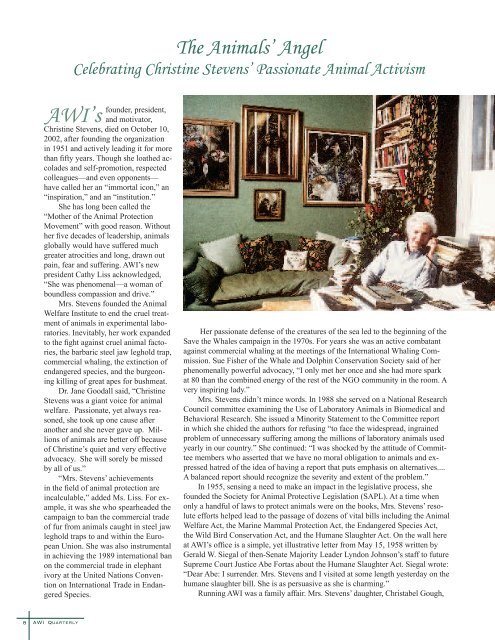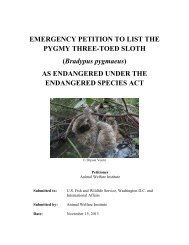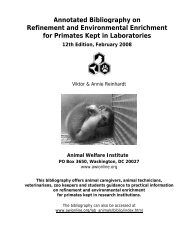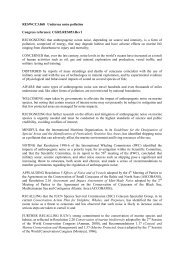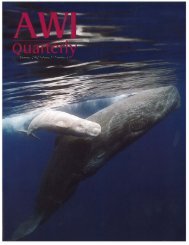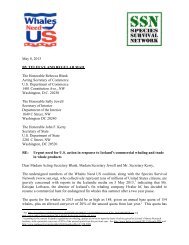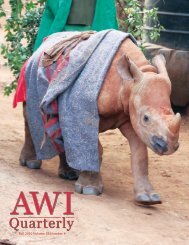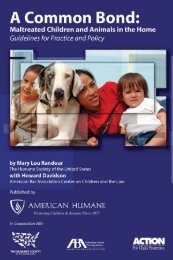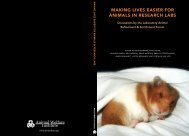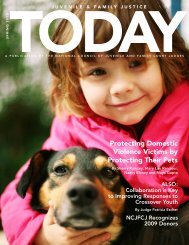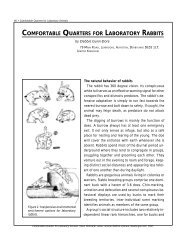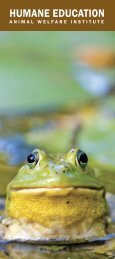You also want an ePaper? Increase the reach of your titles
YUMPU automatically turns print PDFs into web optimized ePapers that Google loves.
The <strong>Animal</strong>s’ AngelCelebrating Christine Stevens’ Passionate <strong>Animal</strong> ActivismAWI’sfounder, president,and motivator,Christine Stevens, died on October 10,2002, after founding the organizationin 1951 and actively leading it for morethan fifty years. Though she loathed accoladesand self-promotion, respectedcolleagues—and even opponents—have called her an “immortal icon,” an“inspiration,” and an “institution.”She has long been called the“Mother of the <strong>Animal</strong> ProtectionMovement” with good reason. Withouther five decades of leadership, animalsglobally would have suffered muchgreater atrocities and long, drawn outpain, fear and suffering. AWI’s newpresident Cathy Liss acknowledged,“She was phenomenal—a woman ofboundless compassion and drive.”Mrs. Stevens founded the <strong>Animal</strong><strong>Welfare</strong> <strong>Institute</strong> to end the cruel treatmentof animals in experimental laboratories.Inevitably, her work expandedto the fight against cruel animal factories,the barbaric steel jaw leghold trap,commercial whaling, the extinction ofendangered species, and the burgeoningkilling of great apes for bushmeat.Dr. Jane Goodall said, “ChristineStevens was a giant voice for animalwelfare. Passionate, yet always reasoned,she took up one cause afteranother and she never gave up. Millionsof animals are better off becauseof Christine’s quiet and very effectiveadvocacy. She will sorely be missedby all of us.”“Mrs. Stevens’ achievementsin the field of animal protection areincalculable,” added Ms. Liss. For example,it was she who spearheaded thecampaign to ban the commercial tradeof fur from animals caught in steel jawleghold traps to and within the EuropeanUnion. She was also instrumentalin achieving the 1989 international banon the commercial trade in elephantivory at the United Nations Conventionon International Trade in EndangeredSpecies.Her passionate defense of the creatures of the sea led to the beginning of theSave the Whales campaign in the 1970s. For years she was an active combatantagainst commercial whaling at the meetings of the International Whaling Commission.Sue Fisher of the Whale and Dolphin Conservation Society said of herphenomenally powerful advocacy, “I only met her once and she had more sparkat 80 than the combined energy of the rest of the NGO community in the room. Avery inspiring lady.”Mrs. Stevens didn’t mince words. In 1988 she served on a National ResearchCouncil committee examining the Use of Laboratory <strong>Animal</strong>s in Biomedical andBehavioral Research. She issued a Minority Statement to the Committee reportin which she chided the authors for refusing “to face the widespread, ingrainedproblem of unnecessary suffering among the millions of laboratory animals usedyearly in our country.” She continued: “I was shocked by the attitude of Committeemembers who asserted that we have no moral obligation to animals and expressedhatred of the idea of having a report that puts emphasis on alternatives....A balanced report should recognize the severity and extent of the problem.”In 1955, sensing a need to make an impact in the legislative process, shefounded the Society for <strong>Animal</strong> Protective Legislation (SAPL). At a time whenonly a handful of laws to protect animals were on the books, Mrs. Stevens’ resoluteefforts helped lead to the passage of dozens of vital bills including the <strong>Animal</strong><strong>Welfare</strong> Act, the Marine Mammal Protection Act, the Endangered Species Act,the Wild Bird Conservation Act, and the Humane Slaughter Act. On the wall hereat AWI’s office is a simple, yet illustrative letter from May 15, 1958 written byGerald W. Siegal of then-Senate Majority Leader Lyndon Johnson’s staff to futureSupreme Court Justice Abe Fortas about the Humane Slaughter Act. Siegal wrote:“Dear Abe: I surrender. Mrs. Stevens and I visited at some length yesterday on thehumane slaughter bill. She is as persuasive as she is charming.”Running AWI was a family affair. Mrs. Stevens’ daughter, Christabel Gough,was her mother’s colleague and trustedadvisor and served on the board fora decade. Mrs. Stevens’ husband of60 years, Roger L. Stevens, foundedWashington’s John F. Kennedy Centerfor the Performing Arts and servedas Treasurer for AWI and SAPL. Mr.and Mrs. Stevens used their importantpolitical connections to host foreigndignitaries and leaders in the Americangovernment. Mrs. Stevens possessedwhat AWI’s Ben White called a “gracefuland lovely” presence, which servedas the “ultimate disguise.” She neverpassed an opportunity to push heragenda of animal protection. For instance,Mrs. Stevens donned a raccoonmask at one party to expose the plightof animals cruelly trapped for their fur.In one terrific photo of Mrs. Stevens atthe White House, she’s practically glaringat President Clinton as they shookhands in a receiving line. After all, howcould she pass up an opportunity to tellthe President directly that free tradeagreements such as the WTO were potentiallydisastrous for animals?Senator Edward Kennedy, a friendof Mr. and Mrs. Stevens said, “Washingtonis a more civilized place becauseof Christine and she will be greatlymissed.” He continued, “For so manyof us, Christine Stevens will always bethe First Lady of the Kennedy Center.She was as knowledgeable as she wasgracious and a tremendous partner toher devoted husband, Roger. My brotherasked him to lead the effort to establisha national performing arts centerhere in Washington. Together they didan impressive job and, in the process,transformed our capitol city.”The work undertaken by Mrs. Stevenswas always without compensationand she modestly listed her professionas “volunteer work in the area ofanimal protection.” She was a talentedartist who attended the University ofMichigan College of Literature, Scienceand the Arts. Her creative skill,too, was applied to the work of AWI.Mrs. Stevens designed hand-drawn holidaycards each year, a magnificent, detailedelephant t-shirt, and a huge eightfoot high mural of endangered speciesthat adorned AWI’s booth at the 1994CITES meeting. Her artistic eye alsoassisted in the design and publication ofthe <strong>Animal</strong> <strong>Welfare</strong> <strong>Institute</strong> <strong>Quarterly</strong>magazine, for which she served as chiefeditor and writer.Perhaps our colleague Susie Watts,formerly of the Environmental InvestigationAgency, put it best: “When I lookaround me and I see all the huffing andpuffing egos among the world’s animalprotectors, people who cannot claim—and never will be able to claim—to haveachieved anything close to what Christineachieved in her lifetime, I’m just allthe more grateful that she was there. Notmany people can truly be called great orunique. Christine can. Not many of uscould make a list of achievements that’smore than a paragraph long. Christinecould, and then some. Not many of uswill be remembered after we’re gone.Christine will.”“So long as I can, I feel it’s a duty. Why would I stop?”—CShristine tevens, 1918-2002Drawing by Christine StevensChristine in action photomontage, pages 10-11. Top Row: Humane Society of Washtenaw County shelter, Michigan; Trapping protest; President LyndonB. Johnson and Former AWI Assistant Treasurer Adele Schoepperle; Mr. Stevens, May and Follow. Middle Row: President Reagan’s Secretary of DefenseCasper Weinberger; Daughter Christabel Gough at laboratory animal meeting; DC whale demonstration; Countess Wachtmeister, Schweitzer MedallistAstrid Lindgren, Ambassador Wachtmeister; Former AWI Secretary Estella Draper. Bottom Row: Jacqueline Kennedy Onassis, Argentinean AmbassadorOrfila, Mr. Stevens, Vice-President and Mrs. Nelson Rockefeller, and Mr. and Mrs. Henry Kissinger at the Kennedy Center; Congressional Trapping Hearing;John Kullberg, then ASPCA President; DC WTO demonstration; in Australia.8 AWI <strong>Quarterly</strong> Winter 2003 9


